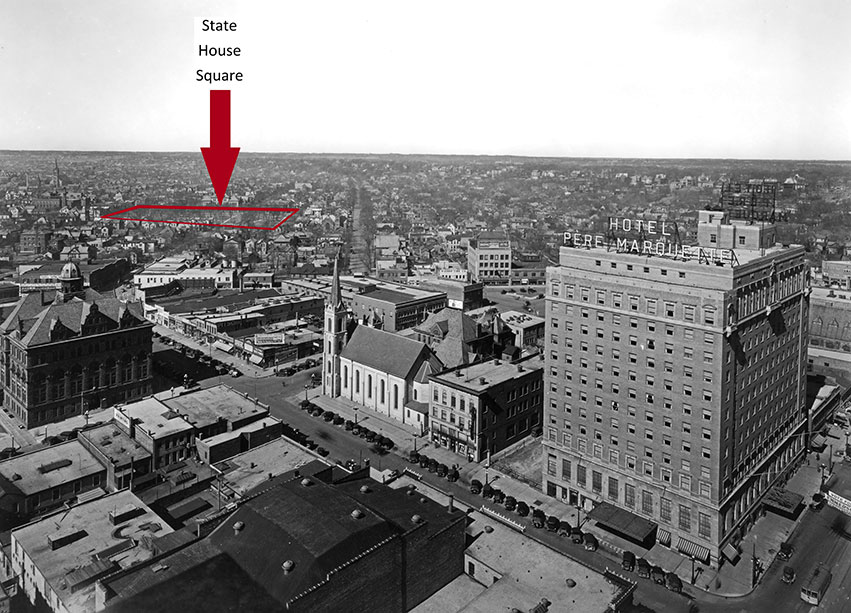
For much of the 19th century, the location of the state capital was an issue of contention for Illinois legislators and citizens. When Illinois joined the union in 1818, the territorial seat of Kaskaskia (which was eventually swallowed by the Mississippi toward the end of the century) became the state capital, hosting the first General Assembly in a modest two-story building.
The capital was moved to Vandalia by 1820, however, due to its more equitable location amongst the southern counties. But when a fire destroyed the capitol building in 1823, a shoddily-built replacement provided a reason for yet another relocation. A public vote was held on the matter in 1834, with Vandalia, Jacksonville, Springfield, Peoria, Alton and the literal geographic center of the state listed as options. Alton won by 427 votes, but legislators deemed the margin too slim to be conclusive, and the issue was shelved until the next general election.
As the matter continued to marinate, Peoria proprietors Monson & Sanford deeded a prime parcel of downtown real estate to the state in 1836 to be used as the location for a proposed new capitol building. Known as State House Square, the lot was maintained as a public park with a fountain, shade trees, seating and walking paths as it awaited its grander purpose.

State House Square, ca. 1890. The tower in the background was part of Peoria's first municipal electric lighting system.
Meanwhile Abraham Lincoln, then a young representative from Sangamon County, introduced legislation to move the capital to the small town of Springfield. The residents of Vandalia banded together and built a $16,000 brick statehouse to secure their hold on the capital, but Springfield made an offer to donate $50,000, along with some of its best land. Lincoln also had the backing of eight colleagues (collectively, the group was called “the Long Nine” due to their combined height of 54 feet), who secured the transfer of the capital to Springfield with an assembly vote in 1837.
The cornerstone for the new capitol was laid that year and the government began operating out of Springfield by 1839—although the building wasn’t complete until 1853. As Illinois prospered, it became necessary to rebuild again, and construction of yet another capitol began in 1868. But public discontent with Springfield continued as perceptions of inefficient construction and improper expenditures circulated.
The campaign to move the capital to Peoria continued through 1871, when some 300 state officials visited the city to view another potential site. It was an event of great pomp and circumstance, but Springfield ultimately prevailed yet again, and the current capitol building was finally completed in 1888 at a then-considerable cost of $4.5 million.
Eventually Peoria’s capital dreams faded. State House Square remained a park until the 1950s, when it was acquired by the park district and turned into a Little League softball field. What might have been a complex of stately government buildings—and the heart of an entirely different city—now comprises the parking lots of the Red Cross, Central Illinois Mortuary Services and Staybridge Suites between Romeo B. Garrett Avenue, Hightower Street, 3rd Avenue and William Kumpf Blvd. iBi
Quotes from Peoria’s “Capital Mania”
Among the arguments in favor of Peoria was a proposal to reimburse the state the $600,000 already spent on construction in Springfield—as well as the city's central location, trade thoroughfare on the river, access to multiple railroads, an extensive postal service, beautiful bluffs and fertile farmland, access to pure spring water, public infrastructure, and a large and wealthy population.
“The locality of Peoria is beautiful as the name is musical.” —Peoria Daily Transcript, March 23, 1871
“But even with abundant rains at both places, Peoria’s streets are solid, while those in Springfield are nothing but loblollies.” —Peoria Daily Transcript, March 23, 1871
“How anybody of common sense came to think of locating the place for the state capital at such a spot as Springfield is unaccountable.” —Peoria Daily Transcript, March 23, 1871
“Public convenience, good taste, and the will of the people were certainly never consulted when Springfield was selected.” —S. De Witt Drown, quoting a correspondent from the St. Louis Republican in 1850
“None of the visitors failed to see and to express the opinion that Peoria was naturally, geographically, and in every way superior to Springfield.” —Peoria Daily Transcript, March 27, 1871 following the legislators’ visit
From the Peoria City Council’s resolution pamphlet following the March 14, 1871 meeting:
“We have often heard it alleged that not a drop of unpoisoned water can be found in any of the country covered by the fatal Sangamon swamps.” —Will County, The Joliet Republican
“There is but one city in the state of Illinois which presents all the advantages which the people generally could desire for their seat of government, and that city is Peoria.” —Cook County, Chicago Times

